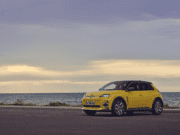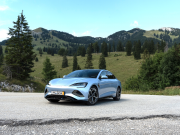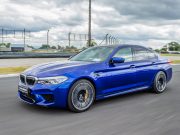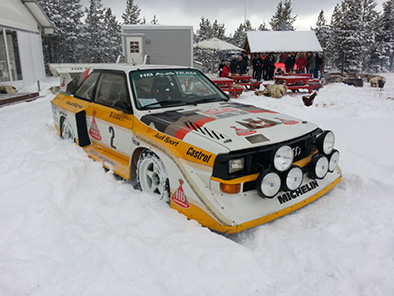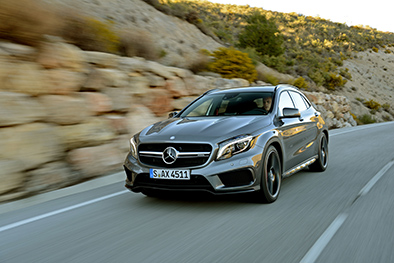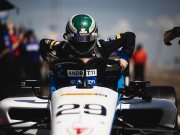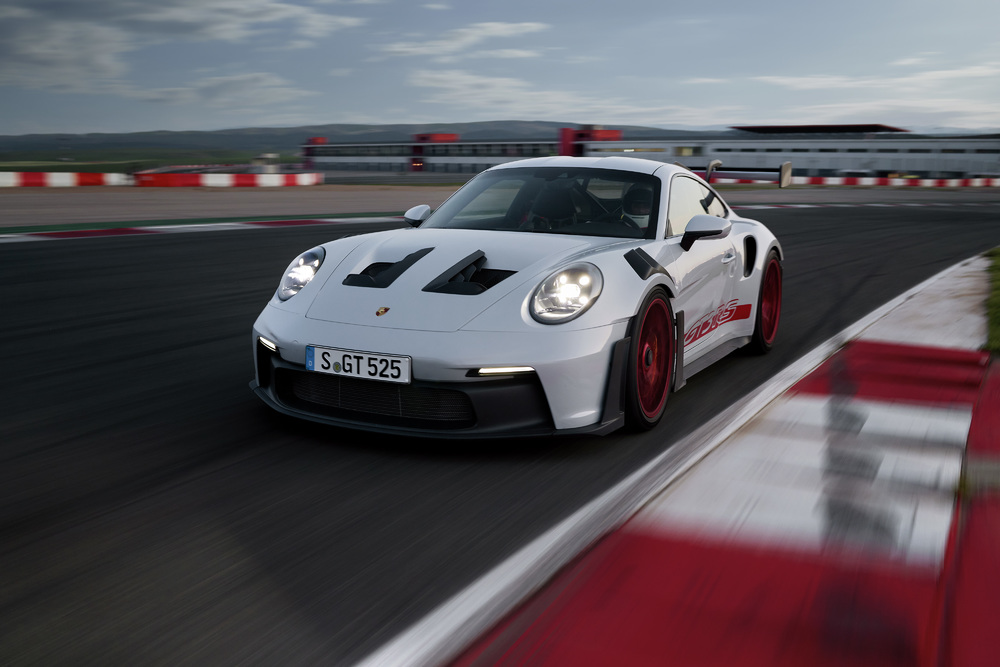 The new Porsche 911 GT3 RS is ready to roll and as usual its designed for maximum performance. The sports car takes full advantage of technology and concepts from motorsport, from its high-revving naturally aspirated 525 PS engine to its intelligent lightweight construction. But it’s the cooling system and aerodynamic elements of the 911 GT3 RS that connect it most directly with its motorsport brother, the 911 GT3 R.
The new Porsche 911 GT3 RS is ready to roll and as usual its designed for maximum performance. The sports car takes full advantage of technology and concepts from motorsport, from its high-revving naturally aspirated 525 PS engine to its intelligent lightweight construction. But it’s the cooling system and aerodynamic elements of the 911 GT3 RS that connect it most directly with its motorsport brother, the 911 GT3 R.
Central radiator concept inspired by motorsport – the foundation for active aerodynamics. A centrally positioned radiator was first used by Porsche in the Le Mans class-winning 911 RSR and subsequently in the 911 GT3 R. Now, it is featured in a road-going 911 model for the first time.
Instead of the three-radiator layout seen in previous 911 models, the new 911 GT3 RS relies on a large, angled centre radiator in the car’s nose, positioned where the luggage compartment is located on other 911 models. This has made it possible to use the space freed up on the sides to integrate active aerodynamic elements. These continuously adjustable wing elements – in combination with the two-part rear wing and a number of other aerodynamic measures – provide 409 kg of total downforce at 124 mph (200 km/h). It means that the new 911 GT3 RS generates twice as much downforce as its 991.2-generation predecessor and three times as much as a current 911 GT3. At 177 mph (285 km/h), total downforce is 860 kg.
The look of the new 911 GT3 RS is characterised by the large number of functional aerodynamic elements. The most prominent feature of the GT3 RS is the ‘swan-neck’ rear wing, which is significantly larger in all dimensions than any wing previously used on a road-going 911. It consists of a fixed main wing and an upper, hydraulically adjustable wing element. For the first time on a Porsche production vehicle, the upper edge of the rear wing extends higher than the roof.
In addition, the front end of the 911 GT3 RS no longer has a front spoiler, but instead features a front splitter that divides the air flowing over and underneath. Sideblades accurately direct air outwards, while front wheel arch ventilation is provided via louvred openings in the front wings. Inlets behind the front wheels, in the style of the iconic Le Mans-winning 911 GT1, reduce the dynamic pressure in the wheel arches. Sideblades behind the intake ensure that the air is directed to the side of the vehicle. Air from the centrally positioned radiator flows out via large nostrils on the bonnet, while fins on the roof direct the air outwards, ensuring cooler intake temperatures in the rear. The openings in the rear side panel are used purely to improve aerodynamics and not to draw in engine intake air. The rear wheel arch also features an intake and a sideblade for optimised airflow, while the rear diffuser is an enhanced version of the one used on the 911 GT3.
Another first for a production Porsche model is the fitment of a drag reduction system (DRS). To achieve low drag and therefore higher straight-line speeds, the DRS allows the wings to be flattened out at the push of a button. There is also an airbrake function, activated during emergency braking at high speeds: the wing elements at the front and rear are set to their maximum angle, creating aerodynamic drag that works in combination with the brakes to improve overall deceleration.
Aerodynamic enhancements even include the suspension components. Because the wheel arches of the new 911 GT3 RS are subject to powerful airflows, the front double-wishbone arms have been designed with teardrop-shaped profiles. These aerodynamically efficient links, normally only used in high-end motorsport applications, increase downforce on the front axle by around 40 kg at top speed. Because of the wider track (29 millimetres wider than the 911 GT3), the front axle arms are also correspondingly longer.
To maintain downforce balance between the front and rear axles when braking from high speeds, pitching under braking has been significantly reduced. To achieve this, the front ball joint of the lower trailing arm has been set lower on the front axle. The multi-link rear axle has also been adjusted, with modified spring rates. Working in harmony with these changes, the driver assistance systems and rear-axle steering have an even more dynamic setup.
The 911 GT3 RS offers three driving modes: Normal, Sport and Track. In Track mode, the basic settings can be individually adjusted. This includes the rebound and compression damping for the front and rear axles, which be adjusted separately and in several stages. The differential can also be adjusted, using rotary controls on the steering wheel. This is done quickly and intuitively with an operating and display concept borrowed from motorsport: four individual rotary controls and a button for the DRS are located on the steering wheel. These rotary controls are displayed with graphics in the instrument cluster during the adjustment process. The 911 GT3 RS also features the track screen already familiar from the 911 GT3: at the touch of a button, the driver can reduce the digital displays on the two seven-inch side displays to essential information only. The gearshift indicators to the left and right of the analogue tachometer have also been taken from the GT3.
The 4.0-litre high-revving naturally aspirated engine has been further optimised compared with the engine in the 911 GT3. The increase in power to 525 PS (386 kW) is achieved primarily by using a new camshaft design with modified cam profiles. Its single-throttle intake system and the rigid valve drive are derived from motorsport. The seven-speed Porsche Doppelkupplung (PDK) has a shorter final drive ratio than the 911 GT3, further improving acceleration, while air intakes on the underbody ensure that the transmission can withstand extreme loads during frequent track use. The 911 GT3 RS accelerates from zero to 62 mph (100 km/h) in 3.2 seconds and reaches a top speed of 184 mph (296 km/h) in seventh gear. Despite this high performance, the model achieves a combined fuel economy of 21.1 mpg and CO2 emissions of 305 g/km (WLTP).
The front axle features six-piston aluminium monobloc fixed-position calipers with 408 mm diameter discs. Compared to the 911 GT3, the piston diameters have been increased from 30 to 32 mm, while disc thickness has been increased from 34 to 36 mm. The rear axle continues to be fitted with 380 mm brake discs and four-piston fixed calipers. Porsche Ceramic Composite Brakes (PCCB) are available as an option, and feature 410 mm discs on the front axle and 390 mm discs on the rear axle. The new 911 GT3 RS comes standard with forged light-alloy centre-lock wheels, fitted with 275/35 R 20 front and 335/30 R21 rear tyres, ensuring a high level of mechanical grip.
Intelligent lightweight construction has been a basic principle of all RS models ever since the legendary 911 Carrera RS 2.7. Thanks to an array of lightweight construction measures such as the extensive use of carbon fibre reinforced plastic (CFRP), the 911 GT3 RS weighs in at only 1,450 kg (DIN kerb weight: vehicle including 90% fuel and all fluids). The doors, front wings, roof and bonnet, for example, are made from CFRP, and this material is also used in the interior, for example in the standard full bucket seats.
The interior of the GT3 RS is finished in typical RS style: black leather, Race-Tex and carbon-weave finish characterise the pure, race-derived ambience. The 911 GT3 RS is available with the Clubsport package at no extra cost, which includes a steel rollover bar, a handheld fire extinguisher, and six-point seatbelts for the driver.
The Weissach package features a carbon-weave finish to the bonnet, roof, parts of the rear wing and the upper shell of the exterior mirrors. The front and rear anti-roll bars, the rear coupling rods and the shear panel on the rear axle are made of CFRP and contribute to a further enhancement of the driving dynamics. The rollover bar, constructed from CFRP for the first time, saves around six kilograms compared with the steel version. Another highlight of the Weissach package is the PDK shift paddles with motorsport-derived magnet technology, which make gear changes even more tactile thanks to a more precise pressure point and a clearly perceptible click. A further option available with the Weissach package is magnesium forged wheels, which save another eight kilograms.
Customers will also be invited to explore the potential of the new car, and further develop their own skills behind the wheel, by participating in a bespoke driving experience around the unique tracks at the Porsche Experience Centre, Silverstone.





